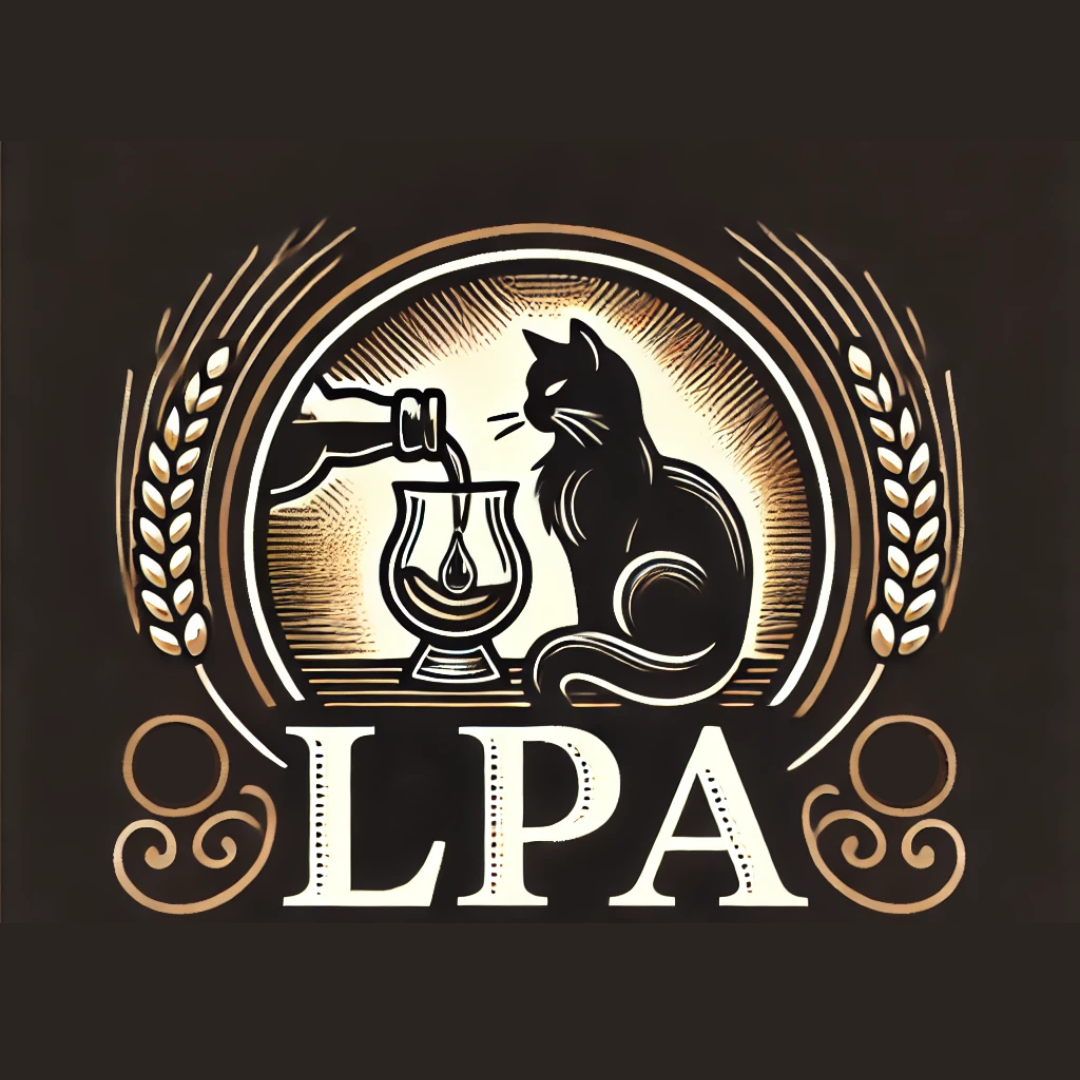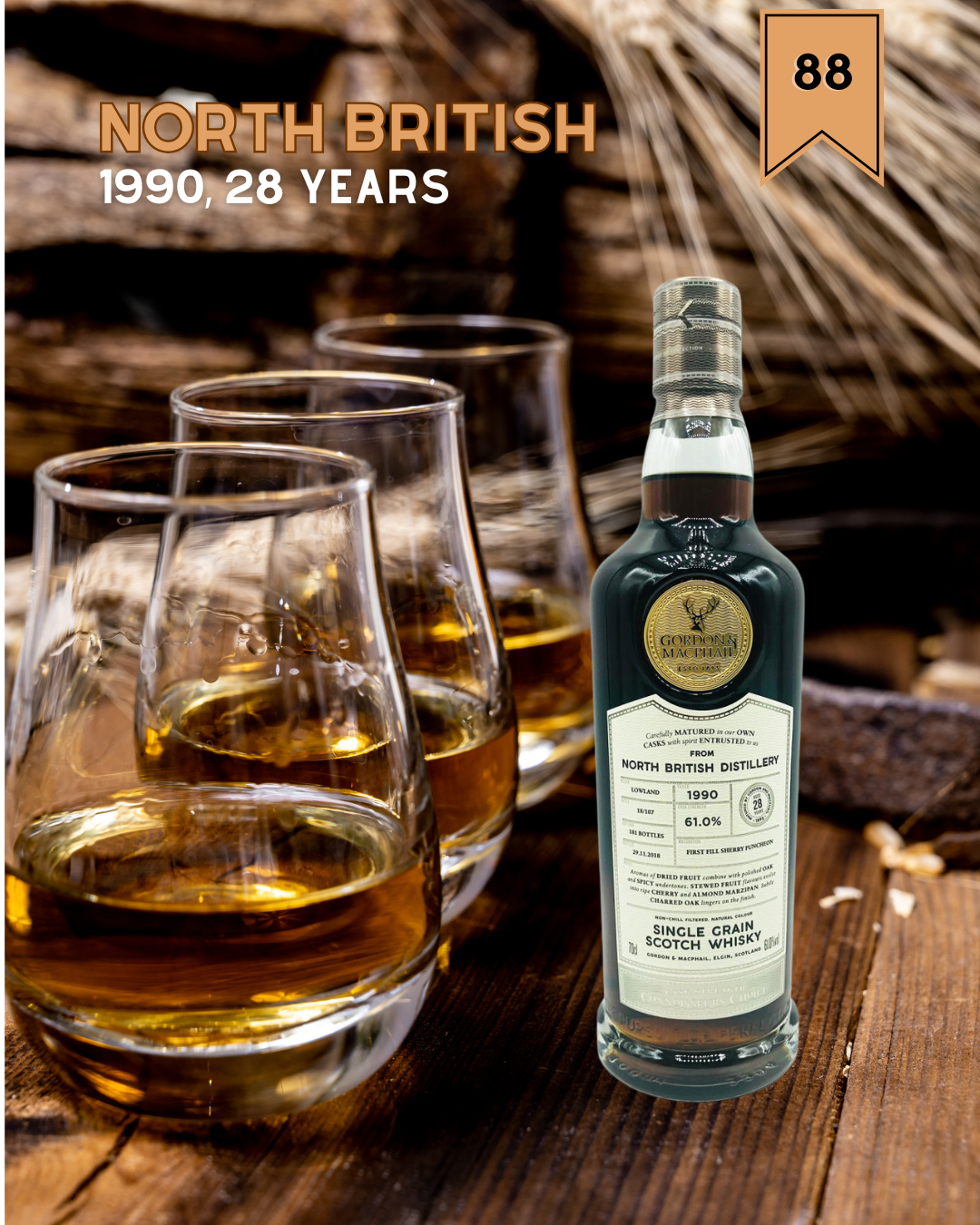A single grain(storm) blog with (almost) all distilleries
How often do we get the chance to taste almost all single grain whiskies from the different distilleries in one blog? Well, never, unless you are lucky like me. This blog was conceived around one sample (the North British) but through shares and gifts I suddenly found myself in the possession of a lot more! Why not combine them in one big single grain whisky superblog? So we have four out of seven from the working distilleries, and one that was closed some while ago. While googling for this information, I came across Starlaw Distillery. Anyone ever heard of that one? Apparently, this is an operation started in 2010 and run by La Martiniquaise, the company that owns Glen Moray and brands like Label 5. Now you know. We have yet to come across a sample of a single grain whisky from that one. If you have tips, reach out!
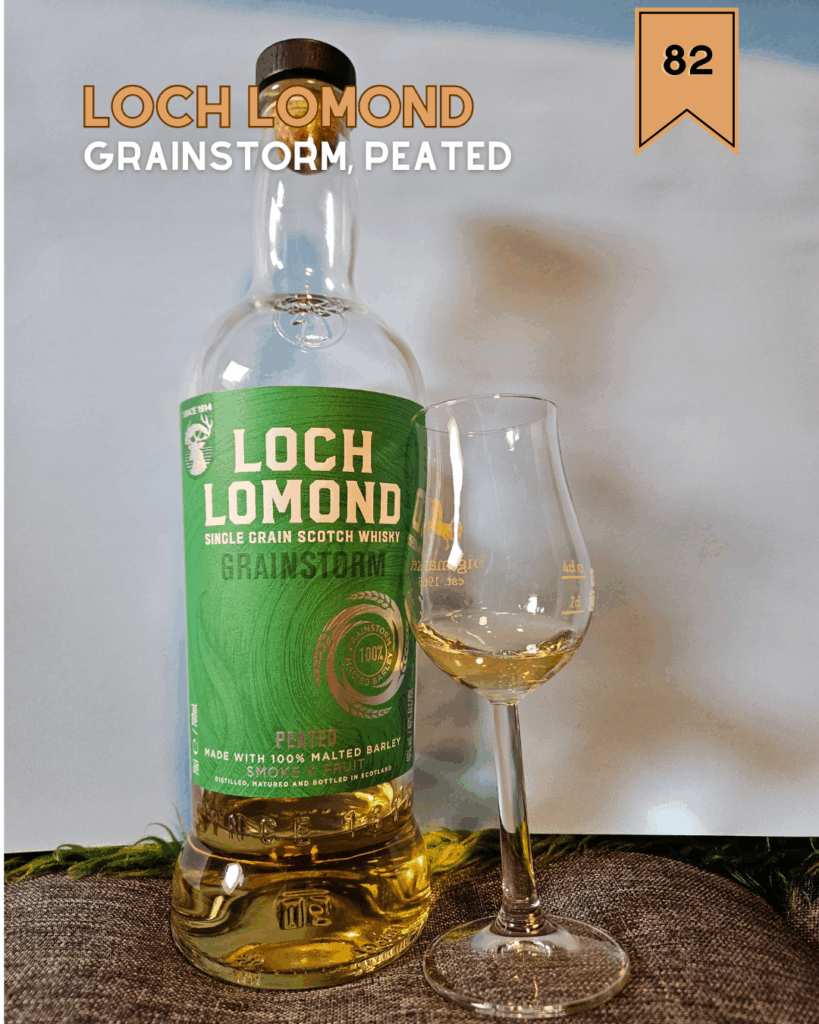
Loch Lomond Grainstorm, Peated, bottled at 46 % abv
First things first: Loch Lomond is this unique distillery that could make a single blend, because they have a collection of stills under one roof. Also a Coffey Style Continuous Still, in which they distilled 100 % malted barley, that was also peated. Matured in fresh and refill bourbon casks, but also “Mit Zuckercolor” (coloured with caramel). Oy Loch Lomond, that is outdated practice!
Upon Sipping: This should be simple enough: the peat is there upfront but because of the purifying nature of grain distilling, it is very faint and subtle. Not in a weak kind of way, just mellowed out in the glass. What is nice about using peated barley for continuous distilling, it that it seems to take away this very chemical or glue-like element that grain whisky has. Therefor, on the nose, you could easily mistake this Loch Lomond Grainstorm for a young lightly peated malt. The taste is light and vanilla sweet, and the peat is much stronger here than the nose would suggest. Very dark and brooding, with hints of chocolate, rye bread and iodine you normally find on Islay.
Word to the Wise: Positively surprised by this very rounded, nice little whisky. The peat is very strong on the palate, and that gives the Loch Lomond Grainstorm a lot of backbone. Well done!
Score: 82 points.
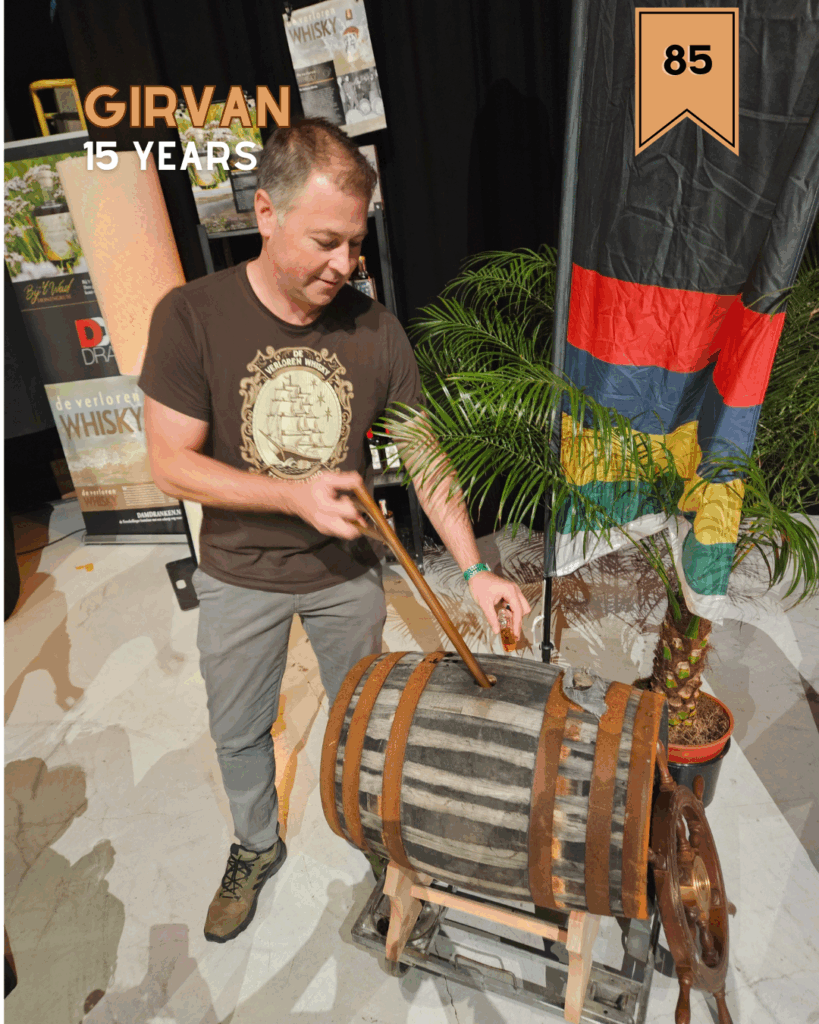
Girvan 15 years old, cask sample at 56 % abv
First things first: Girvan is one of the most energy efficient distilleries in Scotland, according to sources, and owned by the same family that owns Glenfiddich and Balvenie. Joris Dam of Dam Dranken is a guy who plays around with whisky, and has presented already quite a few very nice experiments to the world. This Girvan single grain was put into an restructured oloroso cask and now matures further on the Dutch isle of Terschelling. Joris kindly poured us a sample on The Art of Drinks festival in Amsterdam on 20 October 2025.
Upon Sipping: And a good oloroso cask it is, which is not a given these days! Delightful red fruit on the nose, mixed with this typical glue-like smell from grain whisky. Presented like this, it works like a charm. The clash between these elements creates a floral style all together. Then comes the caramel fudge into play. Lovely nose! The drinking experience is really suited for those with a sweet tooth, but the alcohol kick makes this Girvan very strong and even more mature than the “just” 15 years. As you will see below, higher ages are very common for grain whisky, but Joris found one that already delivers at 15 years. The wood does the heavy lifting of course, but with water you can balance that out and get some breaded notes. Bread with a sweep of Nutella on it.
Word to the Wise: This Girvan can easily stand between a single malt setup. If I am not mistaken, Joris will bottle this cask sooner or later, and then you should look out for a bottle!
Score: 85 points.
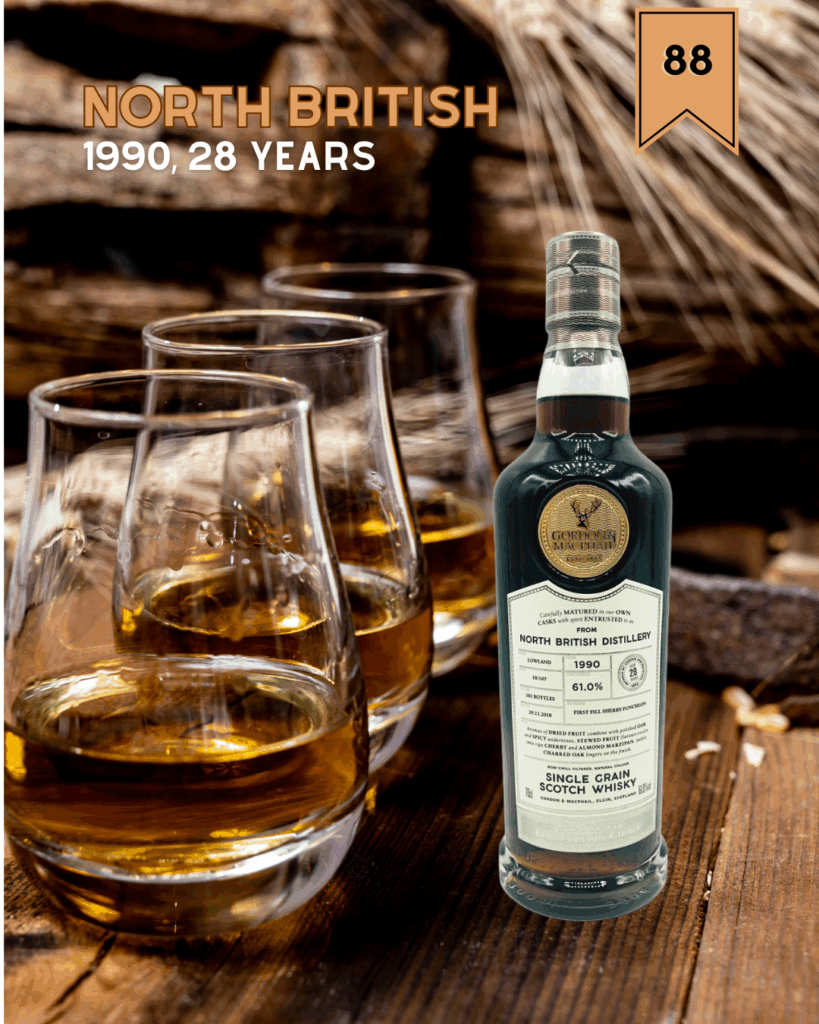
North British 1990, 28 years old, bottled at 61 % abv by Gordon & MacPhail
First things first: Matured in a first fill sherry puncheon after being distilled on 23 October 1990. The colour certainly rubbed off on the single grain, because when it was bottled on 29 November 2018 the whisky came out pitch black. Cask #73847 produced 181 bottles in the Connoisseurs Choice – Cask Strength range. North British is the Edinburgh based grain facility.
Upon Sipping: This blog comes online almost exactly 35 years after this liquid was produced at the North British Distillery. After 28 years, the abv is still crazy high. What does this tell us? In any case, from first sniff, the cask seems to have been excellent. Dark, very dark notes of furniture polish, purple cherries and lots and lots of woodsmoke. Did whoever put the liquid in, know what an excellent cask they had at their hands? Put a Macallan in this and you’re golden! But no, destiny waited for this humble North British spirit to perform a wonder. The palate is greeted with an ultra-soft, silky whisky, that does not disclose any secrets. The finish is of course a powerhouse blast of alcohol, incredible wood impact and smoke. Bitterish cold coffee and chocolate are the expected flavours, and we get that. It does not, however, feel over the top.
We add some water. The sniffing becomes an even bigger pleasure. The puncheon was simply perfect, no other words for that, the imprint that it leaves on this North British goes to show that a cask like this can save even the humblest distillate. And let us be honest, single grain whisky is an amplifier, rarely a character.
But my oh my, does the North British stand tall on this one! Now, with some water, we must admit it starts to struggle. A lot more traditional sweetness from the spirit comes through, almost as if torn away from the sherry influences. Still, it remains a cracking dram. Was this a cask that was treated with paxarette? This feels like a reference to that old practice.
Word to the Wise: Wonders do happen sometimes, and this North British single grain whisky shows it worked well with an exceptional cask. G&M does not often bottle single grain in their Connoisseurs Choice range, but I understand why they picked this one. Very impressive.
Score: 88 points.
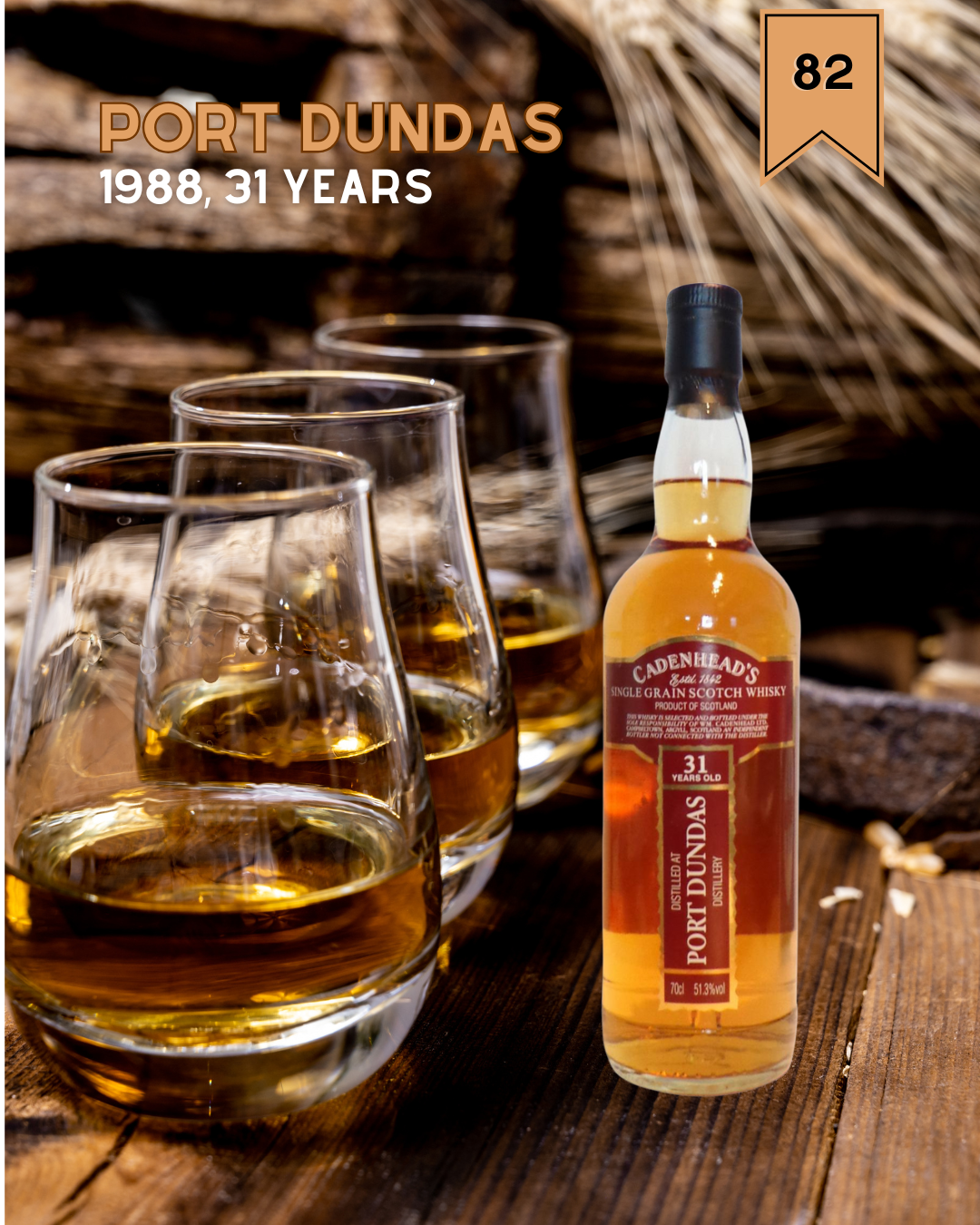
Port Dundas 1988, 31 years old, bottled at 51,3 % abv by Cadenhead’s
First things first: Matured in a bourbon hogshead for 31 years, this was put into 216 bottles in 2020. Bottled in the Closed Distilleries series by Cadenhead’s. Port Dundas was one of the original founders of DCL, the current day Diageo. The Glasgow distillery sadly closed on the threshold of its bicentenary in 2010. Fun fact: Port Dundas was the first distillery described in Alfred Barnard’s standard work about the distilleries of the UK.
Upon Sipping: A rather shy and subdued nose to begin with, only a faint whiff of the usual suspect. Maybe some whiffs of diesel oil, but not much else. We will try with water later, first a sip. The introduction is that of bitter vanilla, but the creamy texture promises more fruit. Like a sticky toffee pudding ready to be devoured. Towards the exit, this Port Dundas more closely resembles a well-aged bourbon whiskey, totally assimilated by the wood and dark chocolate notes mixed with vanilla that is outstaying its welcome. A complex dram, but not very inviting. Enormous contrast with the Invergordon 1972, that was tasted in the same session. I am glad I choose to do that one first, and finish with this Port Dundas. Water brings out more diesel fumes, yes, this is just a very industrious whisky. Would single grain whisky be made in Campbeltown, it would smell like this. It does hide more though, a floral bouquet that is actually quite nice when given time. But sadly, it turns into stale vase water. It suffers from major unbalance. The taste is fine but with water it looses punch. The bitter notes towards the end turn sugary.
Word to the Wise: Not the worst effort, far from it, but this Port Dundas single grain whisky is too much all over the place. It will in any case greatly please lovers of bourbon.
Score: 82 points.
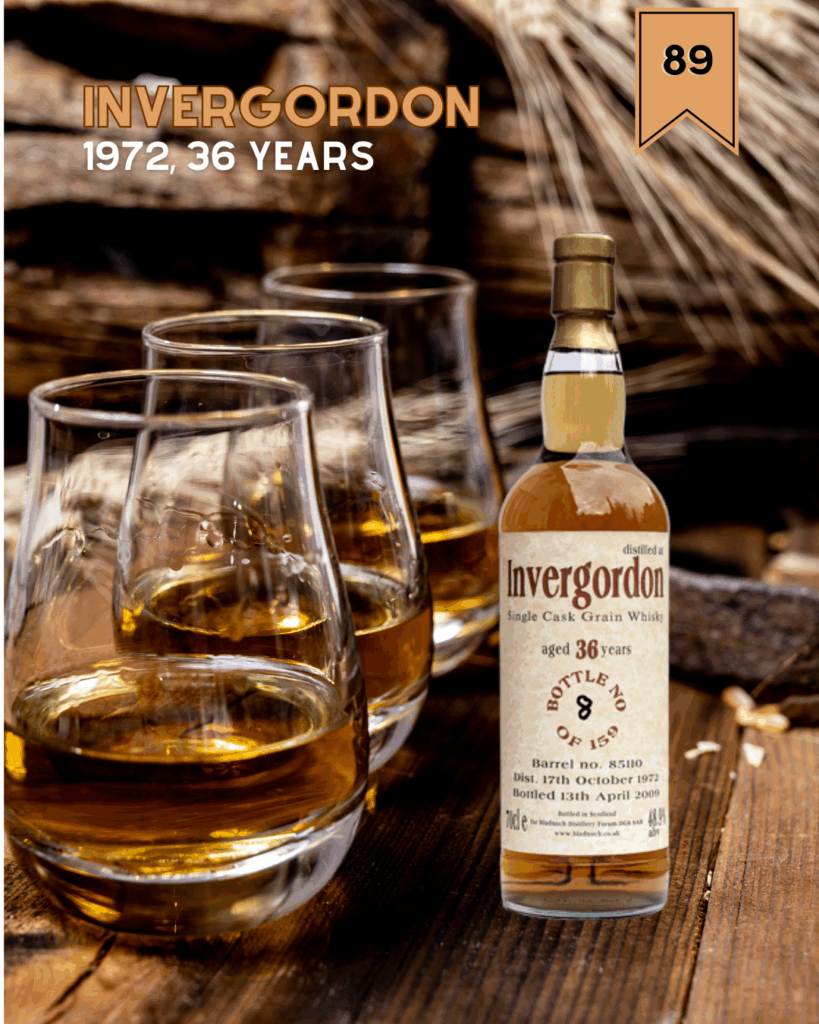
Invergordon 1972, 36 years old, bottled at 48,9 % abv by Bladnoch Forum
First things first: Ah, the Bladnoch Forum, that was something in the early days of internet! But also a very renowned bottler in the time, with reasonably priced Port Ellen and very old Caol Ila. This Invergordon was distilled on 17 October 1972 and bottled on 13 April 2009. It matured in barrel #85110 and yielded just 159 bottles. I actually remember drinking this stuff when visiting the Bladnoch Distillery in June 2009. Good memories. Invergordon is a rather young grain distillery, starting production in 1961. There is now a website and even some longer aged products.
Upon Sipping: These were legends back in the day, for their affordable quality for a 1970s whisky. When you stick your nose in the glass, it is still very much recognisable as a grain whisky though, with this typical glue element. The mouth is where the quality shines, with a perfect creamy vanilla texture coating the tongue, before heading to an extremely tropical finish. Perhaps the slightest bitter wood in the ultimate end, but not bothersome considering this is 36 years old. On repeated sips, you get more and more fruit on the tongue. It is mostly the finish that I enjoy. Such juiciness. With a little water, the wood is also provoked on the nose then, like walking into a lumberyard, but in no way is this a working factory where the sawdust hangs in the air. If there ever was a single grain whisky that you should at least try, it is the Invergordon from 1972 vintage.
Word to the Wise: Only on the nose, this Invergordon does not deliver enough to enter the realm of the greats, but all things considered this is a legendary dram. Maybe its fragile nature makes it even more precious to drink. I enjoyed my new encounter with this Invergordon 1972.
Score: 89 points.
